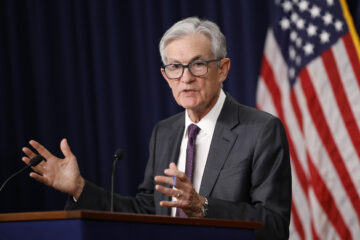Tesla’s profit margins narrowed sharply over the fourth quarter, but Elon Musk has stuck to his target of a 50% growth rate for annual deliveries.
Updated at 4:39 pm EST
Tesla (TSLA) – Get Free Report posted stronger-than-expected fourth quarter earnings Wednesday, and even as cost cuts ate into the group’s profit margins CEO Elon Musk said he plans to outpace his forecast for a 50% annual delivery growth rate.
Tesla said adjusted earnings for the three months ending in September were pegged at $1.19 per share, up nearly 40% from the same period last year and 6 cents ahead of the Street consensus forecast of $1.13 per share.
Group revenues, Tesla said, rose 37.6% from last year to $24.32 billion, just ahead of analysts’ forecasts of a $24.03 billion tally.
Gross automotive margins were 25.9%, Tesla said, a big decline from the 27.4% figure from last year and the 27.9% figure recorded over the third quarter, owing to big price cuts in the U.S. and China as well as costs linked to the ramp-up of production in Berlin and Texas.
“As we progress into 2023, we know that there are questions about the near-term impact of an uncertain macroeconomic environment and, in particular, with rising interest rates,” Tesla said.
“The Tesla team is used to challenges, given the culture required to get the company to where it is today. In the near term we are accelerating our cost reduction roadmap and driving towards higher production rates, while staying focused on executing against the next phase of our roadmap.”
Tesla shares were marked 0.5% lower in after-hours trading immediately following the earnings release to indicate a Thursday opening bell price of $143.70 each.
Tesla delivered a record 405,278 new cars over the three months ending in December, up 31.5% from the same period last year but shy of analysts’ forecasts, with 2022 deliveries pegged at 1,313,851. That’s a 40% increase from 2021 levels but well south of CEO Elon Musk’s promise of 50% growth rates.
“We are planning to grow production as quickly as possible in alignment with the 50% CAGR target we began guiding to in early 2021,” Tesla said. “In some years we may grow faster and in some we may grow slower, depending on a number of factors. For 2023, we expect to remain ahead of the long-term CAGR with around 1.8 million cars for the year.”
That tally would only imply a 27% growth rate, however, and even that pace may be difficult to maintain,given both the challenges Tesla faces in ramping-up production at new factories in Texas and Berlin and weakening demand prospects in key Asia markets.
Tesla began cutting the price of its Model 3 and Model Y vehicles in China last October, with similar reductions unveiled in the U.S. shortly after, and then deepened earlier this month after the group posted disappointing December quarter delivery figures.
Tesla slashed the price of its Model 3 and Model X sedans, along with the Model Y crossover, by between 6% and 20% for U.S. customers, pegging the Model 3 at just under $53,000.
The moves come parallel to the impact of a $7,500 federal tax credit — which now applies to certain Tesla cars following last night’s price cuts — for electric vehicle purchases put in place earlier this year as part of President Joe Biden’s Inflation Reduction Act.


